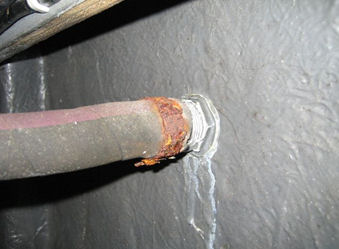Hose Clamps
One of the simple items I look at during a survey are the hose clamps at every through-hull fitting. What am I looking for, specifically? First, I check to see that all connections below the waterline are double clamped. I often find that they are not and I’ll point this out to my client. Hose clamps are not all created equal, and some are more prone to failure, as you’ll see. If a hose clamp fails and it doesn’t have a second one as a backup, the vessel is in danger of sinking fast.
Here’s an example of an economy hose clamp following a brief period of service in the marine environment.
There are several reasons why this happens. First, when you tighten a hose clamp, it’s not very hard to over-tighten some of them, particularly the inexpensive ones with the perforated band. Imagine that you’ve tightened a single hose clamp to a point just before the band strips or the compressed screw housing opens up. Add a little vibration from the engine or bilge pump, for example, and the hose clamp will eventually explode. In addition, the tension screw on the cheaper ones is often prone to backing-off from vibration. In either case, the hose will ultimately work free from the through-hull fitting and sink your boat.
The second reason we look for two hose clamps also keys off of one of the general indicators of a potential problem -- rusty hose clamps. A rusty, corroded hose clamp is the result of using the wrong hose clamp for the job. This is not the place to save a few coins by picking up the “all stainless” version from your local home improvement center or discount store. Beware of the label -- some of these have been known to be made of a lesser grade of stainless steel or to have an “all stainless” band and a mild steel screw. In either case, they won’t last long and you may be risking catastrophe by going cheap.
So what do I recommend? Look for hose clamps with rounded edges and a non-perforated band, made of either Type 316 or Type 304 Stainless Steel. Put a nut-driver on them every now and then to make sure they’re snug. And always, always double clamp hoses on through-hull fittings below the waterline.
Here’s a real nightmare. I’m not going to sea in this boat!
This is what your hose clamps should look like.


